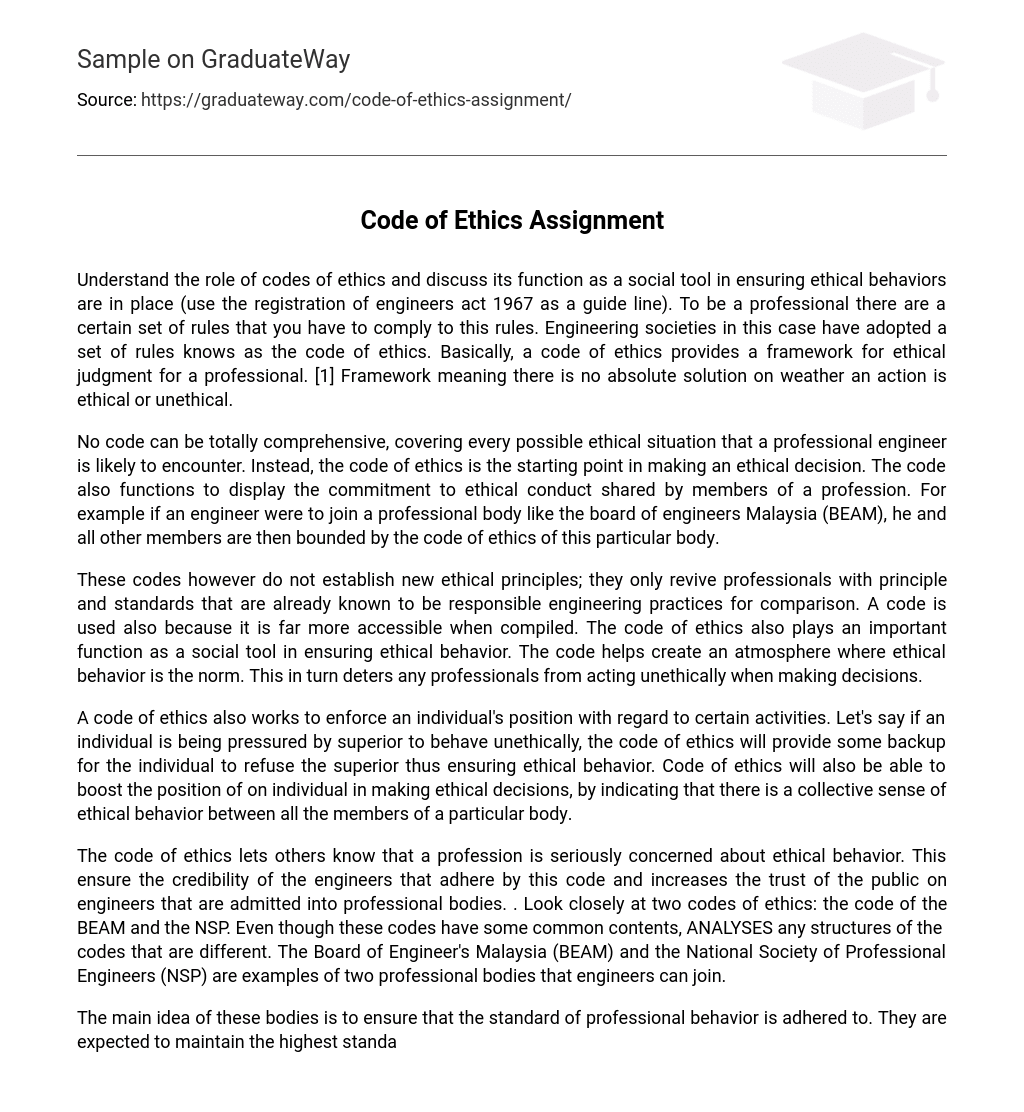Gain an understanding of the significance of codes of ethics and examine their role as a social instrument in guaranteeing the presence of ethical behaviors, with the registration of engineers act 1967 serving as a guideline. To be deemed a professional, adherence to a specific set of regulations is necessary. In the context of engineering societies, a set of regulations known as the code of ethics has been adopted. Essentially, this code provides professionals with a structure for making ethical judgments. [1] By definition, this framework implies that there is no definitive answer as to whether an action is ethical or unethical.
The code of ethics is not able to cover every possible ethical situation that a professional engineer might face. It serves as a starting point for making ethical decisions and demonstrates the commitment to ethical conduct within a profession. Joining a professional organization like the Board of Engineers Malaysia (BEAM) would require an engineer to adhere to the code of ethics set by that organization.
These codes serve to revive professionals with principles and standards that are already recognized as responsible engineering practices. However, they do not establish new ethical principles. The use of a code is advantageous because it is easily accessible when compiled. Additionally, the code of ethics serves as a social tool to ensure ethical behavior. It helps cultivate an environment where ethical behavior is expected and discourages professionals from making unethical decisions.
A code of ethics serves the purpose of enabling an individual to uphold their position on particular activities. For example, if someone is being pressured by a higher authority to participate in immoral actions, the code of ethics will provide assistance to resist those commands and adhere to ethical behavior. Moreover, the code of ethics can strengthen an individual’s capacity to make moral decisions by demonstrating that all members within a specific group possess a shared comprehension of ethical conduct.
The code of ethics serves to showcase the dedication of a profession towards ethical behavior, which in turn improves the reputation of engineers who follow it and instills public trust in members of professional organizations. To gain deeper insight, we will analyze two codes of ethics: the BEAM code and the NSP code. Although these codes have similarities, it is important to examine any differences in their structures. Both BEAM and NSP serve as models for inclusive professional associations for engineers.
These bodies aim to enforce professional conduct standards, emphasizing honesty and integrity. Although the codes vary slightly, their fundamental purpose remains consistent: to provide professionals with a framework for ethical decision making. Notably, the BEAM code aligns with Malaysian law, whereas the NSP code aligns with American law, distinguishing these two codes.
The BEAM code is more detailed than the NSP code when it comes to registering members. It has a section specifically for engineers, covering everything from proper registration to membership inclination and change of address notifications. On the other hand, the NSP code lacks such comprehensive rules for registration. The BEAM code is generally broad, while the NSP code is longer and more intricate.
The members of a society are more likely to read a short code that lacks detail, as compared to a longer code. This ensures that the engineer of that society reads and follows the codes. One difference between the NSP code and BEAM code is that the NSP code does not prevent its members from trying to influence overpayment action. Additionally, the NSP code allows competitive bidding for engineering services, whereas the BEAM code does not have a provision for this.
The BEAM code stipulates that private practice engineers must obtain approval from the Board before entering into a professional partnership with anyone other than a professional engineer in private practice, a registered architect, a registered quantity surveyor, or a licensed land surveyor. In contrast, the NSP code does not address this requirement. The BEAM code serves to ensure that all members of the partnership, being professionals, abide by the rules and standards outlined in the code of ethics.
The BEAM code specifies that a professional engineer cannot act as a payment intermediary for his client unless specifically requested by the client. Additionally, he is not authorized to enter contracts or place orders for the project unless authorized by the client. This provision is not present in the NSP code, but it is generally followed by most professionals. The purpose of this code is to minimize the occurrence of corruption, which is considered unethical and goes against the code’s principles.
NSP incorporates a provision that ensures both junior and senior engineers receive acknowledgment for their work, stating that “engineers shall give credit for engineering work to those to whom credit is due, and will recognize proprietary interests of others”. Conversely, the BEAM code does not have a specific provision addressing this matter. This policy assists junior engineers in being recognized and receiving credit for their diligent efforts.





